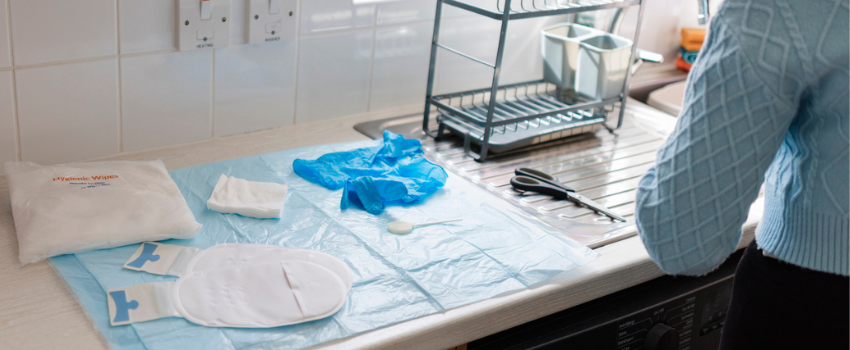
While most people with ostomies never have serious skin issues or complications, you should always be aware of what could happen so you can lower your risks. Since the peristomal skin—the skin surrounding your stoma—is delicate and easily susceptible to damage, it’s important to be diligent about irregularities while keeping the area clean and healthy. If you start to experience skin irritation, inflammation, or notice any discharge, call your doctor. To avoid these problems, take some time to familiarize yourself with the best ways to clean your peristomal skin.
What is Peristomal Skin?
Peristomal skin is the skin that surrounds your stoma—the opening of your abdomen that’s created after an ostomy. This area is delicate and requires different care than traditional skincare regimens. Since you’ll need to clean your stoma and change your ostomy pouch regularly, you’ll soon become familiarized with what normal peristomal skin looks like and when problems are arising.
Recognizing Normal Peristomal Skin
Your stoma should be moist and have a pinkish/reddish appearance—similar to that of the inside of your mouth—and the peristomal skin should look similar to the rest of your abdominal skin. This means that the area, if healthy, is smooth, clean, and dry. There should be no redness or irritation.
Checking Your Stoma
In between changing your pouch and while bathing, check your stoma and peristomal skin for any signs of problems. Stand in front of the mirror or use a handheld mirror if needed. Make sure that the stoma itself is shiny, moist, and pinkish/reddish in appearance and that the surrounding skin is smooth and flush with the rest of your abdomen. Keep an eye out for any of the problems discussed below.
Peristomal Skin Problems to Look For
There are a few telltale signs that your peristomal skin is damaged or irritated—call your doctor if you notice one or more of them. Some potential problems with peristomal skin include the following:
- Irritant Contact Dermatitis – surrounding skin will look red, weepy, and may be accompanied by pain or bleeding. This type of dermatitis is caused by an irritant coming in contact with your skin.
- Mechanical Irritation – the symptoms are similar to irritant contact dermatitis, but this irritation is caused by removing your skin barrier improperly, using too much force, or washing too vigorously.
- Contact Dermatitis or Allergic Dermatitis – this appears as red, irritated skin and is caused due to excessive contact or an allergic reaction to products applied.
- Folliculitis – folliculitis results in tiny, red, painful bumps and is caused by an infection of the hair follicles near your stoma. To reduce folliculitis from developing, avoid shaving your peristomal skin.
- Fungal Infection – fungal infections start as a red rash and can progress when spread. They’re accompanied by itching and burning.
Keeping your peristomal skin clean is the best way to avoid serious complications and problems. If you notice any of the skin problems above, or any other issues, contact your doctor for more information regarding treatment and future prevention.
How to Keep Peristomal Skin Healthy
An effective way to prevent skin problems is to properly clean your peristomal skin. Due to the sensitivity of this area, it’s paramount that you use the right accessories and products.
General Cleaning Tips
While it might seem straightforward, there are a few things that you need to consider when keeping your peristomal skin clean. Always avoid using products that have excessive amounts of residue, moisturizers, and oils as they can affect the strength of adhesion when attaching your pouching system to your skin. Certain soaps can cause skin barriers to weaken, thus increasing your risk for leaks throughout the day.
While you can bathe with your pouch on or off, avoid removing the pouch from a two-piece system prior to showering. Doing so can lead to deterioration of the skin barrier adhesion. Don’t be reserved when cleaning the area—soap and water will not flow into your stoma and cannot cause any damage.
Since certain products can cause irritation or adhesion problems, many people choose to only use water. Cleaning your peristomal skin with water is completely acceptable and will be sufficient. Just make sure that you wash your hands before and after to avoid cross-contamination. If you want to use soap, opt for a mild soap that’s been approved for use in ostomies or a soap made specifically for peristomal skin. If you need to remove any adhesion residue, do so before you wash and then make sure that you wait until the area is completely dry to put on a new skin barrier and reattach your pouching system.
As we mentioned, avoid the use of soaps with oil or moisturizers in them. You should also avoid skin care creams, lotions, powders, baby wipes, isopropyl alcohol, steroidal ointments or medications, and any other excessive products that have not been approved for use by ostomates. Basic cleaning care is the best way to keep your peristomal skin clean.
How to Clean the Skin Around Your Stoma
Cleaning the skin around your stoma isn’t difficult. Using warm water and a washcloth, thoroughly rinse the area around your stoma. If you need to remove leftover adhesion or skin paste, do this first so you can then focus on cleaning the area. Make sure that you get all of the old adhesion off to avoid problems with reattachment after cleaning. Use gently, circular motions and avoid putting too much pressure on an area. Since the stoma doesn’t have any nerve endings, you won’t be able to tell if you’re washing too hard so make sure that you stay focused and are conscious of your movements. Never scrub or use an exfoliating product on the stoma or peristomal skin.
If you see trace amounts of blood, don’t panic. Your stoma has a lot of exposed blood vessels that are delicate and can bleed during cleaning. However, if you notice large amounts of blood or if the bleeding doesn’t stop shortly after cleansing, contact your doctor. Make sure to examine the area after cleansing to look for any signs of a problem, infection, or damage.
Choosing a Skin Barrier
Aside from using the proper cleaning techniques, one of the best ways to keep your peristomal skin healthy is to choose the right skin barrier. Everyone’s ostomies are different, so you need to find something that works with you. Individual irritants vary so talk to your ostomy nurse or doctor about how to find the right pouching system and barrier. Take the time to regularly measure your stoma and adjust your barrier to fit. Small changes in your stoma, especially after surgery, are normal but if you notice anything drastic contact your doctor.
Using Skin Care Accessories
While it’s recommended that you stick to a very basic skin care regimen, certain accessories can help reduce irritation and improve adhesion. Always talk to your doctor about recommended products and test them at home to make sure they work for you. Some good ostomy products include adhesive remover, barrier wipes, peristomal cleansers, and more. If you’re having trouble with ostomy odor, you can use one of many products to help minimize foul smells. If any product causes irritation or a reaction, stop using it immediately.
Changing Your Pouching System Properly
To maintain clean peristomal skin you need to change your pouching system properly and in a timely manner. If your pouch gets too full, it can cause leaks that irritate the surrounding skin. Talk to your doctor about the frequency in which you’ll need to change your pouch and be patient. New ostomates can often get overwhelmed by the changes that this surgery brings, but pretty soon it will be second nature.
Getting Help for Your Ostomy
If, at any time, you’re unsure of whether or not your stoma or peristomal skin is healthy, don’t hesitate to reach out to your doctor or ostomy nurse. In the meantime, using the proper ostomy supplies and adequately cleaning your peristomal skin is the best way to improve your skin, promote a healthy stoma, and avoid problematic leaks. When choosing supplies for your ostomy, always opt for high-quality, medical grade ostomy supplies. It’s important to find the right system, so try out a few different brands and styles to see what you like best. Your doctor may be able to supply you with samples. At Byram Healthcare, we’re committed to helping improve the life of people living with an ostomy and offer a wide range of ostomy supplies, ostomy bags, and plenty of educational support systems. To get started, check out our product selection guide today.




